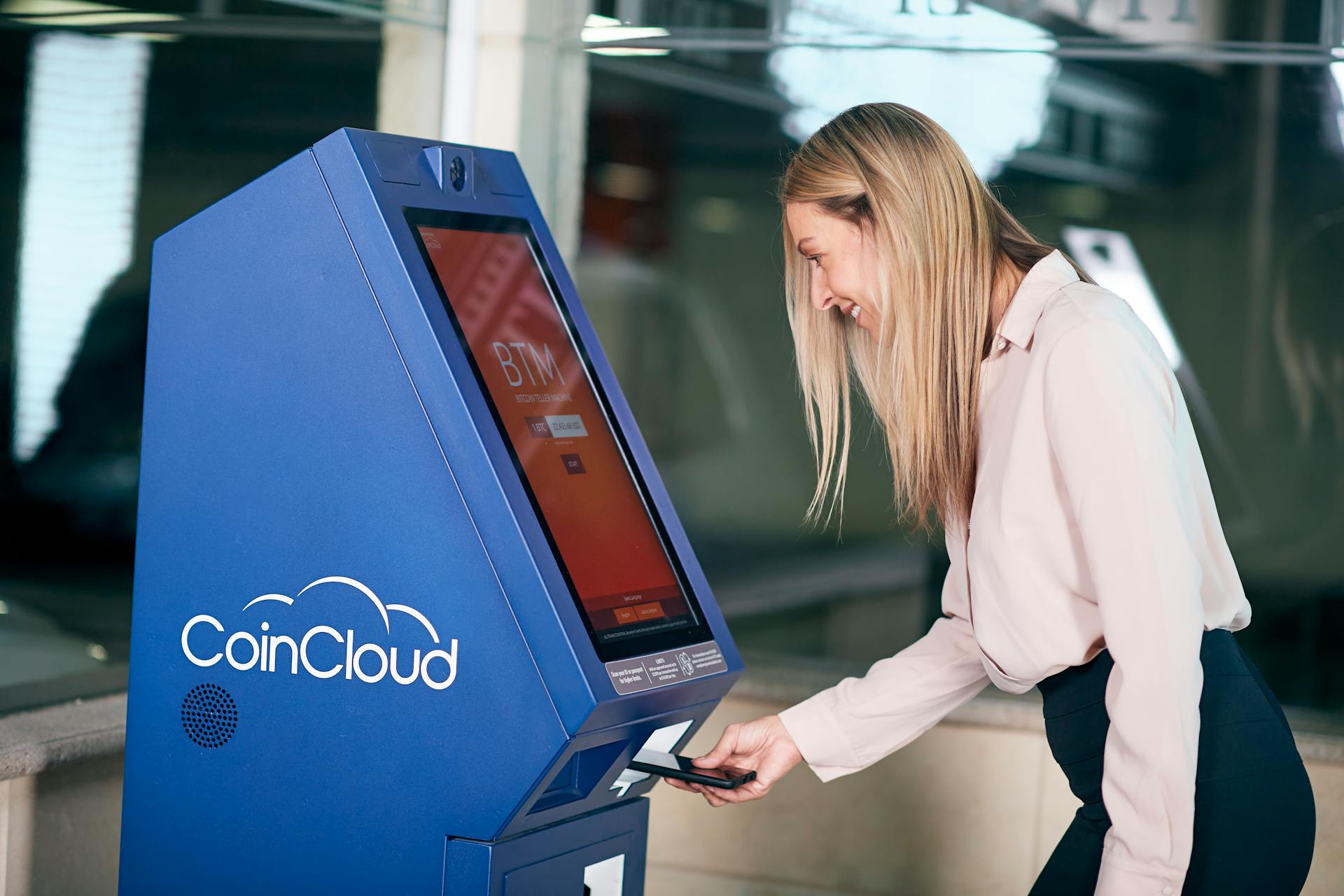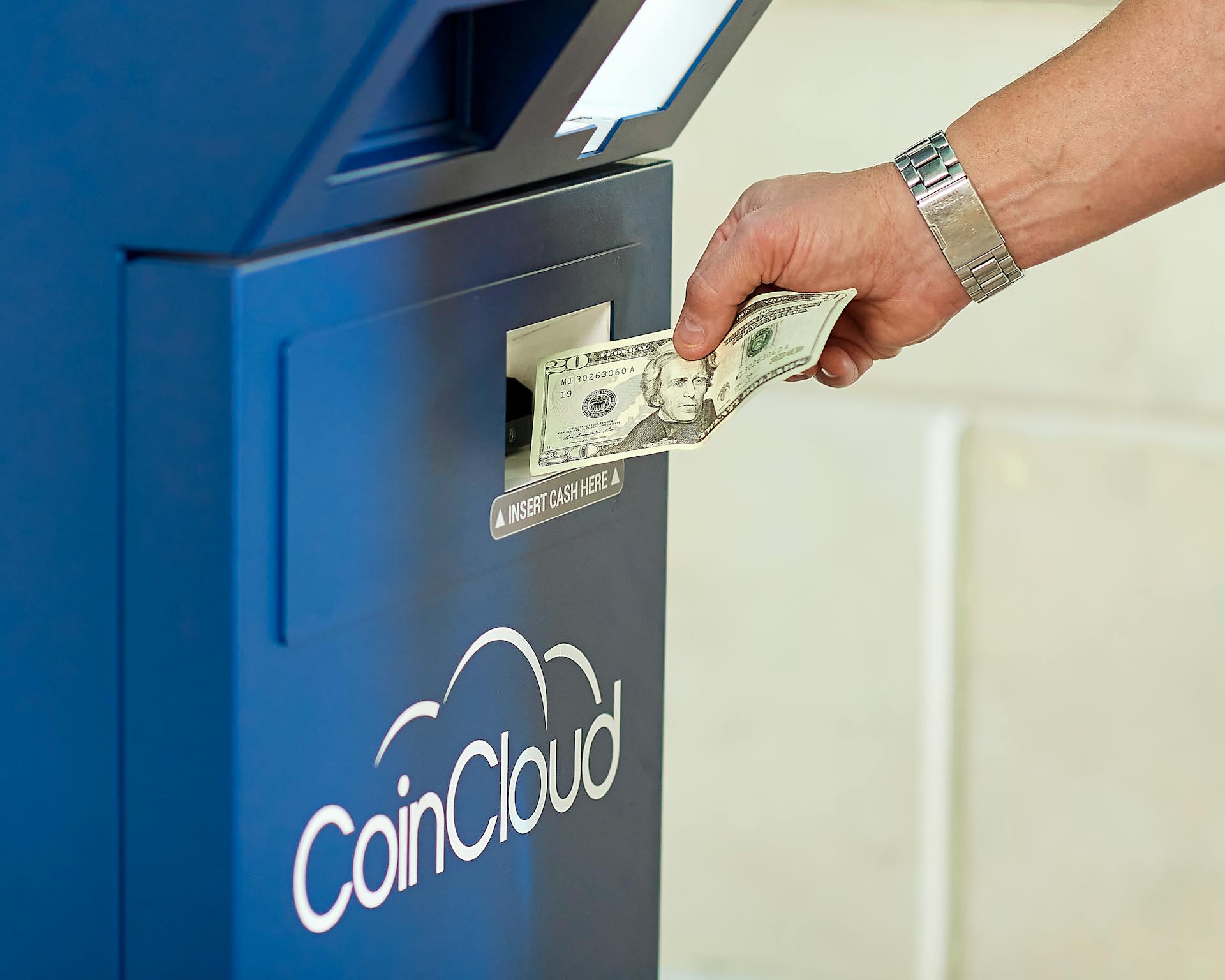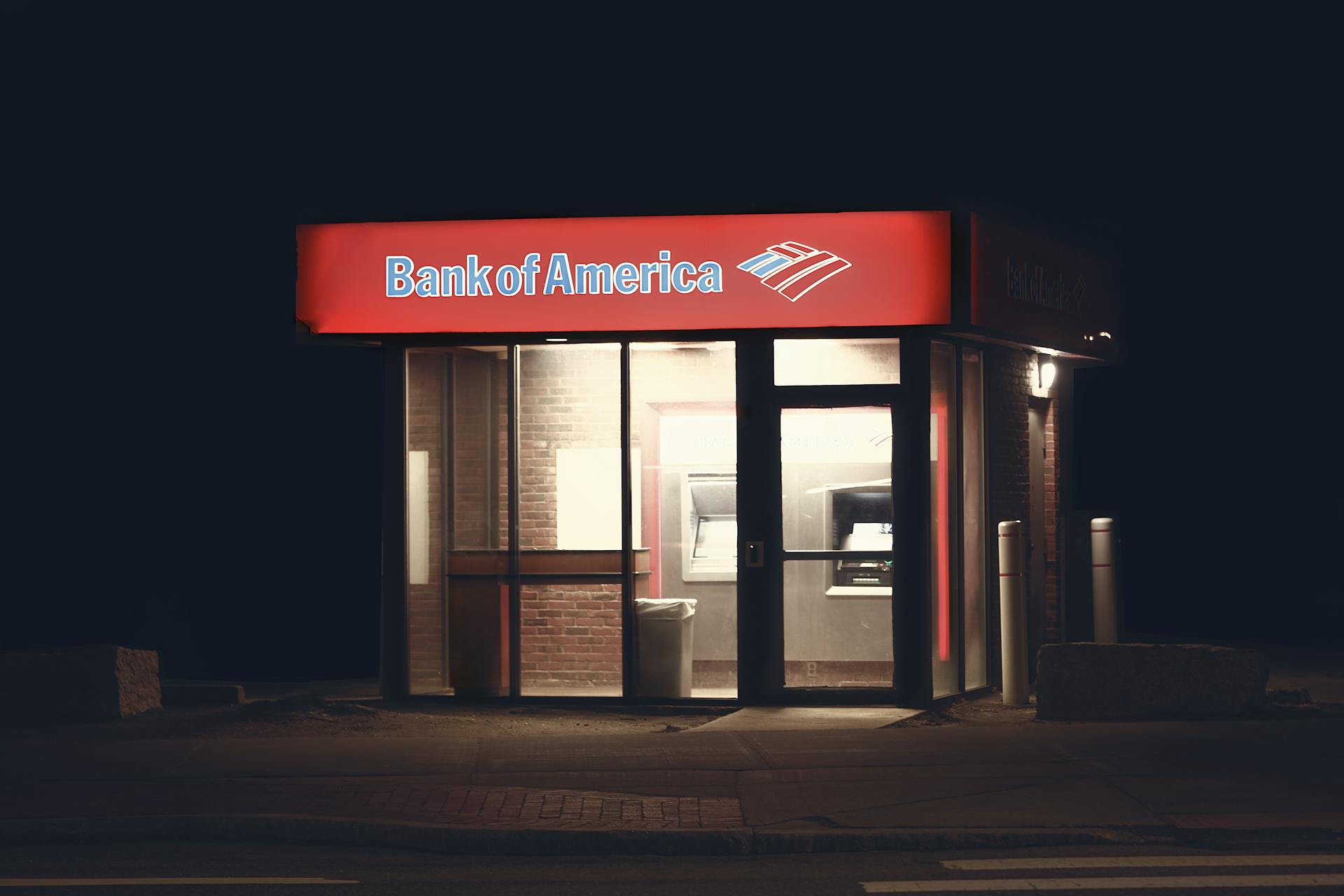
Traveling to Europe can be a thrilling experience, but navigating the local currency and banking systems can be a challenge. Many European countries have their own unique systems for accessing cash, and understanding how to use an ATM machine is crucial for a stress-free trip.
In some countries, like Germany and Austria, you'll find that many restaurants, cafes, and shops accept credit cards, but it's still a good idea to have some local cash on hand.
It's worth noting that some ATM machines in Europe may charge high fees for foreign transactions, so it's essential to choose a reputable bank with low or no fees.
Discover more: Atm Fees Europe
Travel Tips in Europe
Don't rely too heavily on credit cards in Europe, especially in places like Greece where cash is still king. Cash is widely accepted, and having a stash of local currency as a backup is always smart.
In most places, cash machines are easy to find, but in small towns, they might be scarce or non-existent. Make sure to have some cash before heading to a rural destination.
For your interest: Cash Point Atm
Bank-run ATMs are generally more secure and don't charge usage fees, so try to use those instead of independent ones. Look for a credit-card-size slot next to the door to get in.
Avoid independent ATMs like Travelex, Euronet, and Cashzone, as they have high fees and may trick you with "dynamic currency conversion". Don't fall for signs that scream "Free Cash Withdrawals" – it's not true.
European cash machines spit out foreign cash at the day's standard bank-to-bank rate, but remember that your daily limit might not be the same in euros as it is in dollars. You might get an "insufficient funds" message and walk away, thinking your card was rejected, when actually you were asking for too much cash.
Some ATMs have withdrawal limits, so if the machine won't let you withdraw your daily maximum, try several smaller withdrawals to get the total amount you want.
Discover more: How Do You Avoid Atm Fees
Digital Banking Options
Digital banking options are a game-changer for travelers, allowing you to manage your finances completely online with zero monthly maintenance fees. Digital banks like N26 in Europe, Starling Bank in the UK, and Juno in the US offer this convenience.
You can also use a multi-currency travel card, which gives you access to dozens of currencies around the world. The Wise Account and Revolut are two such companies that will convert your money into foreign currency at the real exchange rate.
These digital banks and travel cards are available for residents in many countries, making it easy to stay on top of your finances while abroad.
Readers also liked: Best Atm Card for Europe Travel
Wise Multi-Currency Account
The Wise Multi-Currency Account is a great option for managing your finances while traveling abroad. With this account, you can convert currency at the mid-market exchange rate, which is a big plus.
You can spend, hold, and convert between dozens of currencies with your debit MasterCard. This flexibility is super convenient, especially when you're traveling to multiple countries.
One thing to note is that Wise charges a fee of 1.75% per withdrawal after you've exceeded your €200 monthly withdrawal limit. This is a relatively low fee compared to other options.
Wise is a reputable company with a strong track record of customer satisfaction. In fact, it has a customer satisfaction rating of 9.4 out of 10.
Here's a breakdown of Wise's ratings:
- Trust & Credibility: 9.3
- Service & Quality: 8.9
- Fees & Exchange Rates: 7.6
- Customer Satisfaction: 9.4
Free Account Option
You can open a digital bank account and debit card with zero monthly maintenance fees, thanks to digital "challenger" banks like N26 in Europe, Starling Bank in the UK, and Juno in the US.
These digital banks don't charge foreign card transaction fees and even offer free foreign ATM withdrawals. Some banks, like Revolut, won't charge withdrawal fees as long as you're within your plan limits.
Revolut will charge 2% for any additional withdrawals beyond your plan limits, but you can get a certain number of free withdrawals with your money transfer provider, such as Wise, which offers 2 free ATM transactions each month.
Using a bank-owned ATM, like Chime, can help you avoid added surcharges when you withdraw money abroad, as they waive their charges if you use an ATM in their network, offering access to 60,000+ ATMs without paying a fee.
You might enjoy: How Much Do Atm Machines Charge
Best Debit Cards for Europe
If you're planning a trip to Europe, it's essential to have a reliable debit card that won't break the bank with foreign transaction fees.
Many traditional banks charge foreign transaction fees, but some digital banks offer zero foreign transaction fees for their debit cards.
You can also look for digital banks that offer free ATM withdrawal allowances.
Some debit cards, like Revolut and Wise, offer debit cards with a multi-currency function, converting your money using the real exchange rate for a one-time fee.
Revolut's free account gives you a €200 monthly allowance for free foreign ATM withdrawals, before charging 2% per withdrawal.
Here are some of the best debit cards for Europe, compared in a table:
Some banks, like Charles Schwab and Fidelity, reimburse European ATM fees, but you may still pay 1% for foreign transactions.
It's also worth noting that some travel cards, like Revolut, offer a debit card with the perk of holding and exchanging money in over 30 currencies.
Managing Currency in Europe
Cash is still king in some parts of Europe, especially in Greece, so it's a good idea to have a stash of local currency as a backup.
In most places, cash machines are easy to locate, and you can ask for a distributeur in France, a cashpoint in the UK, or a Bankomat in other countries.
Small towns may have limited or no ATMs, so it's a good idea to have some cash before heading to a rural destination.
Withdraw cash from a bank-run ATM located just outside the bank, ideally during business hours, so you can get help if needed.
Bank ATMs usually don't charge usage fees and are more secure, with surveillance cameras and a small entry lobby that protects users from snoopers and bad weather.
Avoid independent ATMs, such as Travelex, Euronet, and Cashzone, which have high fees and may trick users with dynamic currency conversion.
European cash machines work like home ATMs, spitting out foreign cash instead of dollars, calculated at the day's standard bank-to-bank rate.
If your daily limit is $300 in US dollars, you may be able to withdraw just €275 or so, depending on the exchange rate.
Be aware that ATMs themselves have withdrawal limits, and if the ATM won't let you withdraw your daily maximum, try several smaller withdrawals to get the total amount you want.
A different take: Federal Reserve Cash Vault
It's a good idea to request an odd amount, such as 2,800 Czech koruna instead of 3,000, to avoid getting high-denomination bills that can be difficult to break.
You should always choose to pay in the local currency, such as Euros in Italy, and avoid paying in your home currency, which may trigger dynamic currency conversion fees.
Paying in the local currency can save you money, as the exchange rate is usually more favorable than the rate applied by dynamic currency conversion.
Merchants and ATMs may not be aware of dynamic currency conversion fees, which can be a surprise to travelers.
Companies like Revolut, Monzo, and Monese offer multi-currency card services that can help you avoid dynamic currency conversion fees.
How to Avoid Unreasonable Charges
Avoiding unreasonable charges is crucial when using ATMs in Europe. Euronet ATMs, found in city centers and near tourist areas, are notorious for charging higher usage fees than banks.
You can expect to pay your bank's ATM fees and any fees charged by the ATM provider itself. Some ATMs also charge their own fee for taking out money in Europe.
To avoid these high fees, use ATMs connected to legitimate banks. Bank ATMs usually do not charge usage fees and are generally more secure.
Here's a list of ATMs to watch out for:
- Euronet ATMs
- Travelex ATMs
- Your Cash ATMs
- Cardpoint ATMs
- Cashzone ATMs
These ATMs often have high fees, can be less secure, and may trick users with "dynamic currency conversion."
Charges and Fees
ATM providers charge fees to cover machine upkeep, operation, and banking costs. These fees can add up, especially when you're traveling abroad.
Your bank may also take a profit margin from your transaction, so it's essential to understand their fees before using an ATM. For example, Wells Fargo charges 5 USD per withdrawal from non-Wells Fargo machines outside the US.
You can expect to pay your bank's ATM fees and any fees charged by the ATM provider itself when using an ATM in Europe. Some ATMs also charge their own fee for taking out money, which can result in higher fees if you use an independent machine.
You might like: Wells Fargo Atm Machines
Some banks, like Charles Schwab, offer unlimited ATM cash withdrawal reimbursements, but these only apply to surcharges used to withdraw local currency. You'll get your credit on a monthly basis.
You can also use your Fidelity Debit Card to access ATM fee reimbursements, but you may still pay 1% for foreign transactions. Other accounts, such as SoFi Money Checking, PNC Virtual Wallet Checking, and Ally Bank Interest Checking, may also offer ATM fee reimbursements.
Some ATMs, like those operated by Euronet, charge a cash withdrawal fee, which can be as high as 1% or 3% of the transaction amount. You should also be aware of the currency conversion fee, or 'exchange rate margin', which can be a hidden fee that applies when travellers spend with non-local currency.
Here's a breakdown of the types of fees you might encounter:
- Cash Withdrawal Fee: charged by some ATMs, typically 1% to 3% of the transaction amount
- Currency Conversion Fee, or 'Exchange Rate Margin': a hidden fee that applies when travellers spend with non-local currency
- Service Fee: charged by the physical ATM machine or ATM provider
To avoid unreasonable international ATM fees, it's essential to be aware of the fees associated with each ATM and to choose to pay in the local currency whenever possible. This can help you avoid exorbitant exchange rates and hidden fees.
Sources
- https://www.ricksteves.com/travel-tips/money/cash-machine-atm-tips
- https://www.monito.com/en/wiki/atms-abroad-what-you-need-to-know
- https://wise.com/us/blog/how-to-avoid-atm-fees-in-europe
- https://www.monito.com/en/wiki/atms-in-italy
- https://www.wired2theworld.com/2019/05/04/travel-tip-how-to-avoid-international-atm-fees/
Featured Images: pexels.com


